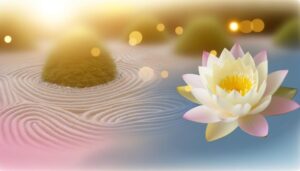How to Create Your Own Sun and Moon Symbol Art
The symbols of the sun and moon encompass profound mystical insights across ancient and modern traditions. Revered as celestial luminaries, the sun embodies divine creation, essentiality, and enlightenment, while the moon reflects mystery, intuition, and the cyclical nature of existence.
Cultures worshipped solar deities like Ra and Huitzilopochtli for their life-giving force and cosmic order, and lunar goddesses such as Selene and Hecate for their potent influence over night and nature. Astrologically, the sun reveals personal strengths, and the moon guides emotional depths.
Artistic depictions and literary motifs weave esoteric wisdom through these celestial symbols. A further exploration beckons deeper truths.
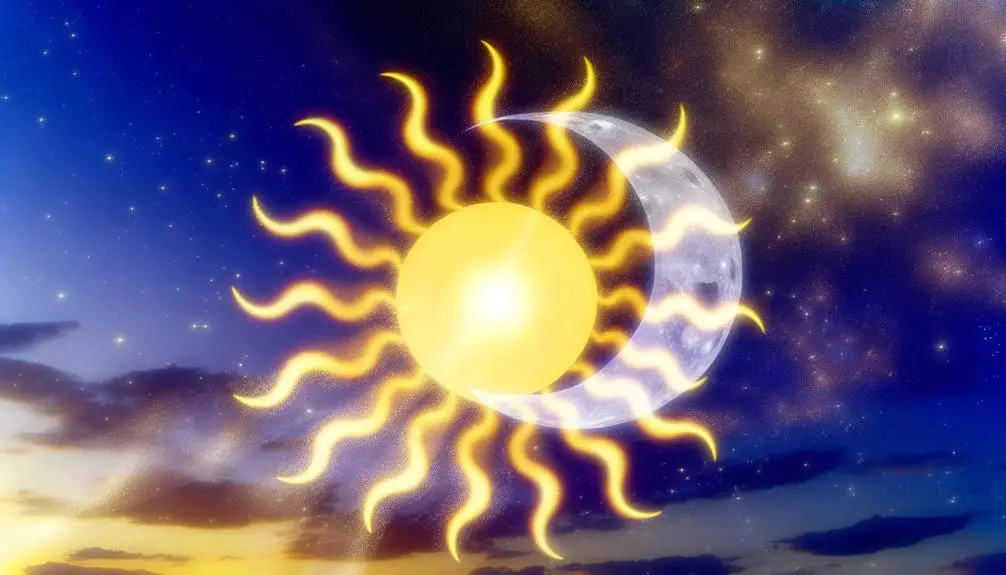
Key Takeaways
- The sun symbolizes clarity, life force, and enlightenment.
- The moon represents mystery, introspection, and emotional depth.
- Together, they symbolize cosmic balance and duality.
- In art, the sun is linked to gold and divine spark, the moon to silver and the subconscious.
- Sun and moon motifs embody masculine and feminine energies, guiding spiritual harmony.
Ancient Sun Worship
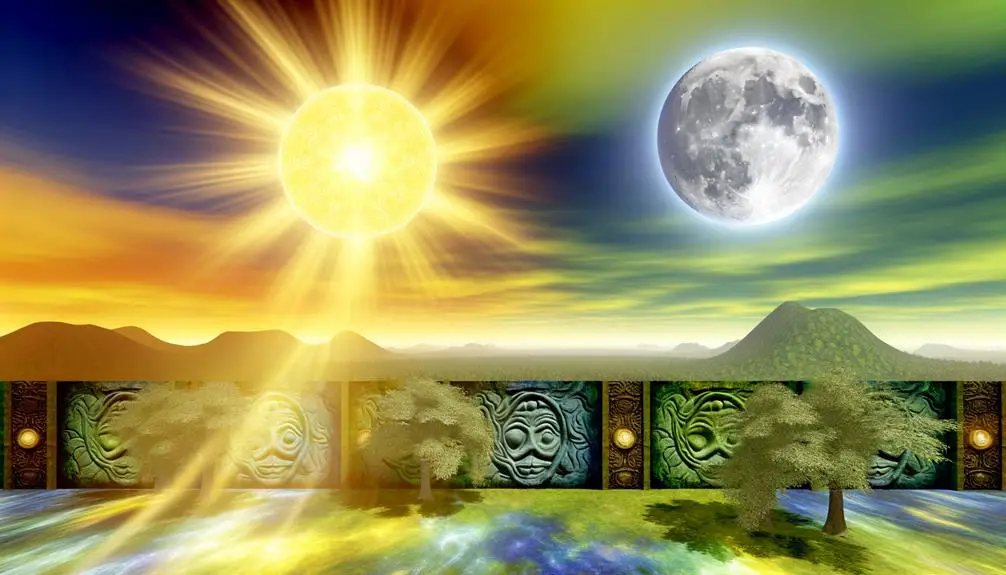
Throughout the annals of human history, ancient civilizations have revered the sun as a potent symbol of divinity and cosmic order, embedding its image deeply within their spiritual and ritualistic practices.
The Egyptians venerated Ra, the sun god, as the sovereign of all creation, whose daily journey across the sky mirrored the eternal cycle of life and death.
In the Vedic traditions of India, Surya, the sun deity, was seen as the eye of the cosmos, illuminating the hidden truths of existence.
The Aztecs offered blood sacrifices to Huitzilopochtli, believing his celestial strength sustained the universe.
These esoteric traditions reveal an archetypal recognition of the sun's essential energy, a divine luminary guiding humanity's spiritual ascent and cosmic interconnectedness.
Moon in Mythology
From the shadowed groves of Greek Artemis to the ethereal glow of the Japanese Tsukuyomi, lunar deities have woven a tapestry of mystery and reverence across civilizations.
The moon's silvery influence has dictated the cadence of rituals, casting a celestial rhythm over sacred rites.
This celestial orb serves not only as a beacon in the night but as a silent orchestrator of humanity's most profound spiritual expressions.
Lunar Deities Across Cultures
In the ethereal tapestry of mythological narratives, lunar deities emerge as enigmatic figures, illuminating the nocturnal domains of diverse cultures with their celestial influence.
Selene, the Greek goddess, rides her silver chariot across the heavens, her luminous presence a beacon in the dark.
Chandra, the Vedic moon god, embodies the cyclical nature of time, his phases mirroring life's ebb and flow.
Tsukuyomi, the Japanese moon deity, governs the night with an enigmatic serenity, a counterbalance to his solar sibling, Amaterasu.
In Aztec lore, the moon goddess Coyolxauhqui represents the eternal struggle of light and darkness.
These lunar deities, cloaked in mysticism, reveal the moon's profound spiritual resonance across the world's mythologies, a celestial narrative of luminous guidance.
Moon's Influence on Rituals
As lunar deities weave their narratives across the mythological spectrum, the moon's influence extends into rituals, casting its ethereal glow upon sacred ceremonies and esoteric practices.
The waxing and waning phases of the moon serve as celestial guides, orchestrating the timing of rites and evoking the cyclical nature of existence.
Ancient civilizations, from the Egyptians to the Celts, revered the moon as a divine compass, aligning their spiritual practices with its luminous rhythm.
The full moon, in particular, is a harbinger of heightened energies, often invoked in rituals of manifestation and transformation.
Within the enigmatic embrace of the new moon, intentions are set and mysteries are explored, revealing the moon's profound role in humanity's quest for transcendence and cosmic harmony.
Solar Deities
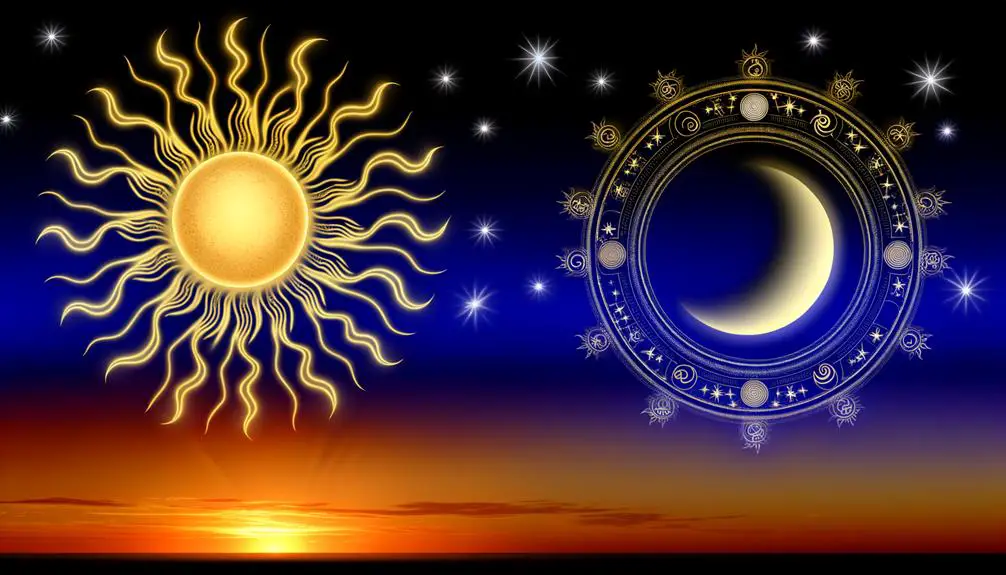
Enigmatic and revered, solar deities symbolize the profound connection between the celestial and the divine, illuminating ancient cultures with their radiant presence. These luminary figures, from Egypt's Ra to the Aztec's Huitzilopochtli, represent not just the life-giving force of the sun but also the eternal cycle of birth, death, and rebirth.
They embody the cosmic order, casting light upon the esoteric path of enlightenment. The sun's fiery essence, often seen as a chariot traversing the heavens, is a potent metaphor for divine insight and spiritual ascendancy.
Devotees sought favor from these deities, believing their blessings would imbue both the mundane and the mystical with energy and clarity, bridging the terrestrial with the transcendent domains.
Lunar Goddesses
The moon, with its enigmatic phases and silvery glow, has long been venerated as the domain of powerful lunar goddesses who preside over the mysteries of the night and the cycles of nature.
Figures such as Selene, Artemis, and Hecate embody the moon's transformative essence, guiding the ebb and flow of tides, emotions, and dreams. Their mythologies weave a tapestry of esoteric wisdom, linking the feminine divine to cosmic rhythms.
Selene's chariot, Artemis's hunt, and Hecate's crossroads each symbolize distinct facets of lunar influence—illumination, protection, and liminality.
These goddesses serve as conduits to the subconscious, inviting seekers to explore the shadowed territories of intuition and inner knowledge, mirroring the moon's ethereal presence in the night sky.
Sun and Moon in Astrology
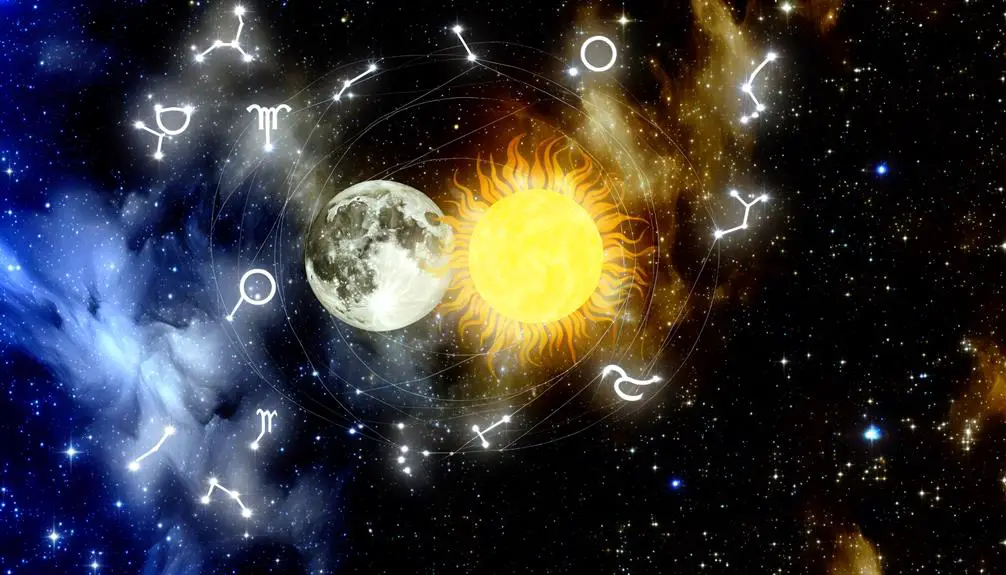
In the celestial dance of astrology, the Sun stands as the radiant beacon of our core identity and life purpose, illuminating the path of personal expression and energy.
Conversely, the Moon, with its silvery glow, governs the tides of our innermost emotions and subconscious currents, weaving a tapestry of intuition and reflective depth.
Together, they form the dual pillars of our astrological essence, harmonizing the external and internal domains of human experience.
Sun's Astrological Significance
Within the celestial tapestry, the Sun radiates as a potent symbol of importance and central authority in astrological interpretation. It embodies the core of one's being, representing the conscious self, essential force, and fundamental identity.
The Sun's placement in the zodiac sign and house reveals one's inherent purpose, illuminating personal strengths and areas for growth. Astrologically, the Sun governs Leo, imbuing it with regal dignity, creativity, and a yearning for recognition.
The solar influence denotes the archetypal Hero's journey, spotlighting the quest for self-actualization and authentic expression. Interwoven with the cosmic dance, the Sun's radiant energy calls forth clarity, energy, and the pursuit of one's true path, acting as the sovereign beacon within the astrological chart.
Moon's Emotional Influence
Shrouded in the veils of night, the Moon emerges as a profound symbol of emotional depth and intuitive wisdom in astrological tradition. Governing the tides of our inner world, the Moon's influence extends to our subconscious, nurturing the fertile ground of dreams and instincts.
Its ethereal glow mirrors the ebb and flow of human feelings, casting light upon our hidden desires and vulnerabilities. The Moon's phases, from the New Moon's inception to the Full Moon's culmination, represent the cyclic nature of emotional experiences.
Through its celestial dance, the Moon beckons us to explore the labyrinth of our psyche, urging self-reflection and emotional growth. In this astral tapestry, the Moon stands as the guardian of our deepest, most authentic selves.
Cultural Symbolism
Emanating an ethereal glow, the sun and moon have long been revered as potent symbols of duality and balance across various cultures.
In the ancient mysticism of the East, the sun is perceived as the Yang, embodying male energy, energy, and creation, while the moon, as the Yin, signifies female energy, intuition, and introspection.
Indigenous cultures often ascribe the sun to the divine masculine and the moon to the sacred feminine, weaving a celestial dance of harmony.
In alchemical traditions, the sun and moon represent the pursuit of spiritual wholeness, the merging of opposites into the philosopher's stone.
Such symbolism transcends time, whispering secrets of cosmic equilibrium to those who seek the profound interconnection of all existence.
Artistic Representations
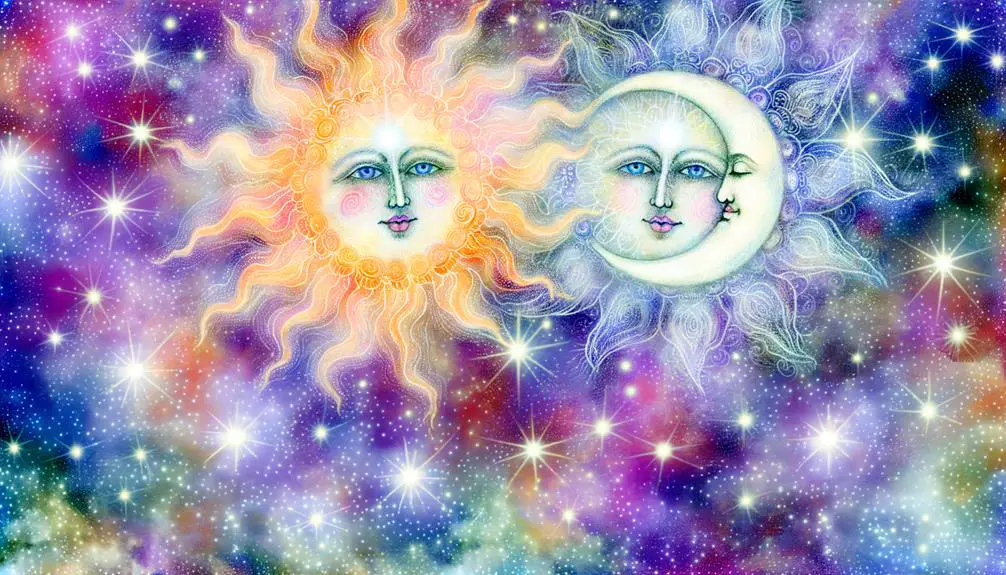
Artistic representations of the sun and moon often serve as profound visual metaphors, encapsulating the ancient dualities and cosmic dance that has captivated human imagination for millennia. These celestial symbols are frequently depicted in harmonious balance, embodying the eternal interplay of light and shadow, creation and destruction.
In alchemical texts, the sun is often linked to gold and the divine spark, while the moon is associated with silver, intuition, and the subconscious. Renaissance artworks evoke this celestial symphony, portraying the sun as the animating force and the moon as the reflective soul.
From the intricate mandalas of Eastern mysticism to the stained glass windows of Gothic cathedrals, the sun and moon continue to be timeless muses, inspiring transcendent art.
Symbolism in Literature
In the domain of literary enchantment, the sun and moon emerge as potent archetypes, weaving through the tapestry of narrative to illuminate themes and motifs of duality and transformation.
These celestial symbols often mirror the inner landscapes of characters, casting light on their symbolic roles and the cosmic dance of their destinies.
Through the alchemy of words, authors conjure the sun and moon to evoke profound insights into the human condition and the eternal cycles of existence.
Archetypal Imagery Usage
The sun and moon, ancient symbols steeped in mythological importance, illuminate the literary landscape with their profound duality and transformative power. The sun embodies clarity, energy, and enlightenment, often depicted as the harbinger of truth and life. Conversely, the moon symbolizes mystery, introspection, and the subconscious, guiding nocturnal journeys of the soul. This celestial dichotomy resonates deeply within the human psyche, evoking a symphony of light and shadow. Writers employ these archetypes to craft narratives rich in esoteric significance, weaving threads of cosmic symbolism that transcend the mundane.
| Symbol | Represents | Literary Archetype |
|---|---|---|
| Sun | Clarity, strength | Enlightenment, hero's journey |
| Moon | Mystery, introspection | Subconscious, nocturnal quest |
| Duality | Transformation | Balance, cosmic harmony |
This interplay of sun and moon reflects the eternal dance of opposites, a timeless motif in storytelling.
Themes and Motifs
Literary landscapes are often infused with the potent symbolism of celestial bodies, where themes of transformation and enlightenment are meticulously interwoven through the motifs of sun and moon.
The sun, radiant and all-seeing, frequently embodies the essence of consciousness and illumination, casting away the shadows of ignorance.
Conversely, the moon, with its waxing and waning phases, symbolizes the cyclical nature of existence, the hidden and the revealed. This duality reflects the profound interplay between light and darkness, knowledge and mystery.
Such motifs serve as conduits for deeper truths, urging readers to explore the liminal spaces within themselves.
These celestial symbols transcend mere narrative devices, becoming vessels of esoteric wisdom and metaphysical exploration in the literary cosmos.
Character Symbolic Roles
As celestial symbols illuminate the thematic tapestry, characters often emerge as living embodiments of the sun and moon, their roles steeped in allegorical significance and esoteric resonance.
The sun, with its radiant energy, often symbolizes characters who bring enlightenment, vitality, and unyielding courage. Conversely, the moon's softer glow reflects characters of introspection, mystery, and emotional depth. These archetypes traverse the literary cosmos, their interactions weaving complex narratives of duality and harmony.
Sun characters evoke the archetype of Apollo, illuminating truth and clarity, while moon characters draw upon the mystique of Artemis, guardians of the night and subconscious domains. Through these symbolic roles, literature transcends the mundane, inviting readers into a dance of light and shadow, wisdom and enigma.
Modern Interpretations
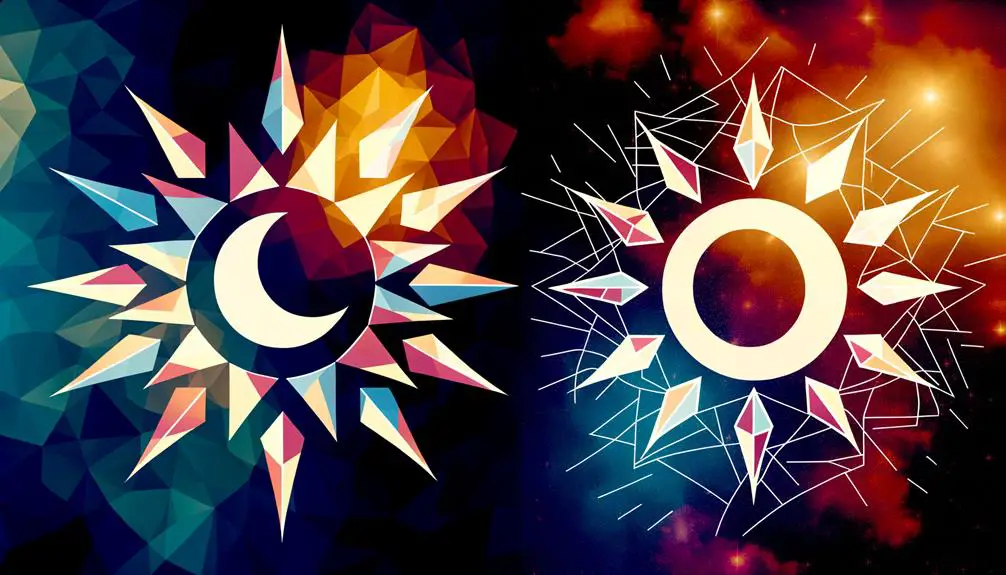
In contemporary spiritual practices, the sun and moon symbols are often reinterpreted to reflect the duality of human nature and the balance between masculine and feminine energies.
The sun, with its radiant, unrelenting light, embodies the active, assertive force, often linked to the divine masculine. Conversely, the moon, with its gentle, reflective glow, symbolizes the receptive, intuitive essence, resonating with the divine feminine.
This celestial dance of light and shadow serves as a metaphor for inner harmony, encouraging individuals to embrace both their luminous and obscure aspects.
Modern mystics and seekers often invoke these symbols in rituals, meditations, and art, seeking to align their spiritual journeys with the cosmic rhythm that the sun and moon eternally portray.
Spiritual Significance
The spiritual significance of the sun and moon transcends their physical presence, serving as profound symbols of the cosmic balance that governs the universe.
In the domain of esoteric wisdom, the sun is often seen as the embodiment of masculine energy, radiating life-giving force and illuminating the path of truth.
Conversely, the moon embodies the divine feminine, its phases mirroring the cyclical nature of existence and the hidden mysteries of the subconscious mind.
Together, they represent the harmonious dance of duality—light and dark, active and receptive, conscious and unconscious.
This celestial union encourages seekers to embrace both aspects within themselves, fostering a deeper connection to the eternal rhythms of the cosmos and the spiritual journey towards wholeness.
Conclusion
The interplay of sun and moon symbols spans millennia, embedding deep esoteric meaning across cultures.
An intriguing statistic to ponder: approximately 1.3 billion adherents worldwide continue to observe lunar and solar festivals, underscoring their enduring spiritual resonance.
This celestial dichotomy, whether through the radiant deities of ancient civilizations or the arcane astrological charts, perpetuates a mystical dialogue between light and shadow, day and night, embodying the eternal dance of cosmic duality.


